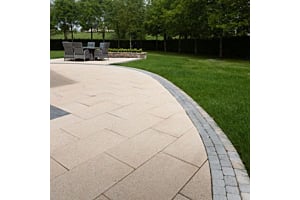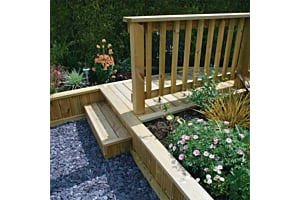Adding a deck to your home is a fantastic way to expand your living space and enhance the beauty of your outdoor area.
However, there are numerous different types of decking boards, made from various materials and each offering unique advantages and aesthetics.
In this decking guide, the expert landscaping team at Haldane Fisher will walk you through the different types of decking materials, and will provide the insight that will help you decide what’s right for you.
Benefits of Timber Decking
It’s hard to go wrong with the tried and tested timber decking. Timber is cost-effective and offers good versatility.
Since most experienced landscapers know how to work with timber, there are a lot of resources out there to guide you through your own project.
While it does offer a classic look, rustic charm, there are some drawbacks.
Timber Decking Drawbacks
- Maintenance required
- Susceptibility to rot and insects
This is especially the case in Northern Ireland, where the rain comes thick, fast and often. However, if you regularly maintain your timber, finishing it off regularly, it will comfortably withstand the test of time.
Types of wooden decking
There are a few different types of wooden timber decking. The two main ones that you have to know about are:
- Softwood - Often a good choice for your subframe, softwood offers good stability and is cost-effective, however might not provide the stability needed for a large deck
- Hardwood - Much more durable, but also a little less versatile. Hardwood offers that perfect finish but can be tricky to work with due to its natural density.
Benefits of Composite Decking
Made from wood fibres and recycled plastics, composite decking is becoming an increasingly popular option for landscaping projects as it combines the benefits of both softwood and hardwood, while also serving as an eco-friendly decking solution.
Compared to timber decking, it is low maintenance and offers exceptional durability - so much so that many of the brands which we offer, like Composite Prime offer warranties.
However, it may not be as suitable for larger projects due to a higher initial cost. If you have the funds, though, composite boards should be considered as a long-term investment option.
Types of composite decking
Composite decking is less varied than timber decking, but there are some options within our range:
- HD Deck® Dual – Composite decking with a reversible two-colour option.
- HD Deck® 3D – Composite decking with a deeply textured wood grain design.
- HD Deck® Pro – Extra-wide composite decking board for larger projects
Composite decking vs timber decking
When considering what you are going to use for your project you need to consider two main things: your budget and the amount of free time that you have.
If you have enough free time to spend protecting your timber decking using oil and stain every few months, timber offers a rustic look and a cost-effective solution.
If you’d rather be more hands-off, composite is likely the option for you, and as an added bonus, it’s very easy to work with and install.
Millboard decking
We also offer Millboard decking, another alternative to traditional timber, which combines a natural look with the performance that real wood cannot match.
At Haldane Fisher we have several finishes too, including both enhanced grain decking and weathered oak.
Much like Composite Prime, it’s an excellent option for your deck as its low maintenance, looks the part, and is incredibly easy to install compared to traditional timber.
Consider What You Are Using Your Decking For
Consider your location, climate, and maintenance preferences and research the durability, maintenance requirements, and cost of each material to make an informed decision.
You can consult with one of our professionals to assess your specific needs and find the best decking material for your project.
Here are a few decking applications which you might want to keep in mind:
Garden Decking:
This is where timber or composite decking is likely to get used.
When building a garden deck, you should consider exposure to elements and your maintenance abilities.
Pool Decking:
Due to the risk of wood getting waterlogged, you will want to go for PVC or composite if you’re making a poolside deck.
The four key things to keep in mind when selecting your deck is:
- Slip resistance
- Water drainage
- Chlorine resistance
- Heat absorption
Roof Decking:
When it comes to selecting roof decking materials, the process is much like garden decking.
The main thing to keep in mind is weather resistance, as your deck would likely not have the coverage that trees may offer in a garden.
Still unsure? Reach out to our experts
By understanding the different types of decking materials available, you can choose the best option that suits your style, budget, and maintenance preferences.
Whether you prefer the natural beauty of wood, the durability of composite, or the modern look of metal, there is a decking material that fits your needs.
If you have any questions about timber options, our team will help you find a product that meets your requirements now.
Your Decking Shopping List
Preparation
- Tape measure - https://www.haldane-fisher.com/tools-workwear/levels-measuring/tape-measures
- Builder’s Line - https://www.haldane-fisher.com/catalogsearch/result/?q=builders+line
- Spirit Level (at least 500mm in length) - https://www.haldane-fisher.com/tools-workwear/levels-measuring/spirit-levels
- Club Hammer - https://www.haldane-fisher.com/faithfull-fibreglass-club-hammer-2-5lb-lhtff00089
- Spade - https://www.haldane-fisher.com/outdoor-landscaping/garden-tools/spades
- Spirit Level - https://www.haldane-fisher.com/tools-workwear/levels-measuring/spirit-levels
- Weed Control Fabric to prevent weed growth - https://www.haldane-fisher.com/geotextile-heavy-duty-weed-barrier-ground-stabiliser-fabric-1-x-15m-lgami00110
- Gravel - https://www.haldane-fisher.com/building-materials/cement-sand-aggregates/aggregate
Sub Frame Essentials
- K Rend K-Post - https://www.haldane-fisher.com/k-rend-k-post-20kg-hcbcp00127
- Galvanised Bolt-Downs - https://www.haldane-fisher.com/boltdown-4-galvanised-lfmfb00106
- Hand Saw - https://www.haldane-fisher.com/bahco-244-7-tpi-handsaw-22-lhtsv00001
- Decking Joists - https://www.haldane-fisher.com/outdoor-landscaping/decking/timber-decking/decking-joists
- Carriage Bolts – size dependent on project https://www.haldane-fisher.com/hardware-ironmongery/nuts-bolts-washers/carriage-bolts
- Combi Drill - https://www.haldane-fisher.com/tools-workwear/power-tools/drills
- Jigsaw for any bespoke cuts in timber if required - https://www.haldane-fisher.com/milwaukee-18v-m18bjs-0-jigsaw-naked-lptml32140
- Mitre Saw for larger projects - https://www.haldane-fisher.com/catalogsearch/result/?q=mitre+saw
- Circular Saw for working with lots of thicker timber if required - https://www.haldane-fisher.com/tools-workwear/power-tools/saws-cutters
- Combination Square - https://www.haldane-fisher.com/stanley-300mm-die-cast-combination-square-lhtsy00022
- Pencil for markings - https://www.haldane-fisher.com/catalogsearch/result/?q=pencil
- Decking Tape to protect the top of your timber joists from moisture - https://www.haldane-fisher.com/composite-prime-hd-protect-tape-63mm-x-20-m-tcptape
For A Timber Decking Project
- Timber Decking - https://www.haldane-fisher.com/outdoor-landscaping/decking/timber-decking
- Decking Screws – size dependent on the project - https://www.haldane-fisher.com/hardware-ironmongery/screws/decking-screws
- Decking Spindles Turned & Planed - https://www.haldane-fisher.com/decking-spindle-turned-treated-900-x-40-x-40mm-tc04040ds
- Decking Spindles Turned & Planed - https://www.haldane-fisher.com/decking-spindle-planed-treated-900-x-40-x-40mm-tc04040s
- Decking Handrail Infill - https://www.haldane-fisher.com/11-x-41mm-decking-handrail-infill-treated-tc011041di
- Decking Posts 3x3 - https://www.haldane-fisher.com/post-cap-small-suits-75-x-75mm-3x3-post-lfegl00465
- Decking Posts 4x4 - https://www.haldane-fisher.com/post-cap-large-suits-100-x-100mm-4x4-post-lfegl00470
- Post Cap "4" - https://www.haldane-fisher.com/post-cap-large-suits-100-x-100mm-4x4-post-lfegl00470
- Drill Bits - https://www.haldane-fisher.com/tools-workwear/power-tool-accessories/bits
For A Composite Decking Project
- Composite Decking Boards - https://www.haldane-fisher.com/timber-sheet/decking
- Decking Screws – size dependent on the project - https://www.haldane-fisher.com/hardware-ironmongery/screws/decking-screws
- Fixing Clips - https://www.haldane-fisher.com/composite-prime-hd-deck-universal-fixing-clip-pack-of-200-tcpfixclipuniv2
Protective Equipment
- Ear plugs - https://www.haldane-fisher.com/portwest-ep02-pu-foam-ear-plug-200-pairs-orange-lsapw02260
- Gloves - https://www.haldane-fisher.com/tools-workwear/safety-workwear/ppe/gloves
- Face Mask - https://www.haldane-fisher.com/tools-workwear/safety-workwear/ppe/face-masks
- Knee Pads - https://www.haldane-fisher.com/tools-workwear/safety-workwear/ppe/knee-protection
- Safety Glasses – https://www.haldane-fisher.com/portwest-pw30-clear-visitor-safety-spectacles-lsapw02140




